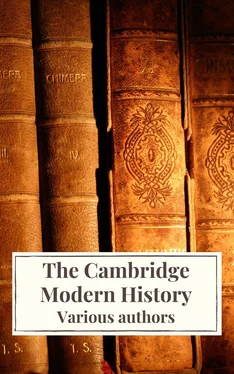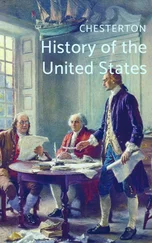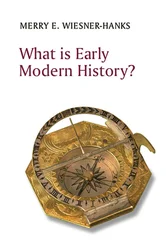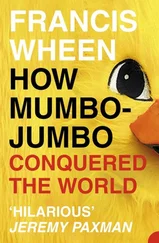R. Nisbet Bain - The Cambridge Modern History
Здесь есть возможность читать онлайн «R. Nisbet Bain - The Cambridge Modern History» — ознакомительный отрывок электронной книги совершенно бесплатно, а после прочтения отрывка купить полную версию. В некоторых случаях можно слушать аудио, скачать через торрент в формате fb2 и присутствует краткое содержание. Жанр: unrecognised, на английском языке. Описание произведения, (предисловие) а так же отзывы посетителей доступны на портале библиотеки ЛибКат.
- Название:The Cambridge Modern History
- Автор:
- Жанр:
- Год:неизвестен
- ISBN:нет данных
- Рейтинг книги:4 / 5. Голосов: 1
-
Избранное:Добавить в избранное
- Отзывы:
-
Ваша оценка:
- 80
- 1
- 2
- 3
- 4
- 5
The Cambridge Modern History: краткое содержание, описание и аннотация
Предлагаем к чтению аннотацию, описание, краткое содержание или предисловие (зависит от того, что написал сам автор книги «The Cambridge Modern History»). Если вы не нашли необходимую информацию о книге — напишите в комментариях, мы постараемся отыскать её.
The first series was planned by Lord Acton and edited by him with Stanley Leathes, Adolphus Ward and George Prothero.
The Cambridge Modern History Collection features all five original volumes:
Volume I: The Renaissance
Volume II: The Reformation, the End of the Middle Ages
Volume III The Wars of Religion
Volume IV: The 30 Years' War
Volume V: The Age of Louis XIV
The Cambridge Modern History — читать онлайн ознакомительный отрывок
Ниже представлен текст книги, разбитый по страницам. Система сохранения места последней прочитанной страницы, позволяет с удобством читать онлайн бесплатно книгу «The Cambridge Modern History», без необходимости каждый раз заново искать на чём Вы остановились. Поставьте закладку, и сможете в любой момент перейти на страницу, на которой закончили чтение.
Интервал:
Закладка:
The correspondence of Alessandra degli Strozzi (1406-71), the biographies of Bisticci, the note-books of Rucellai, Landucci’s Diary, Domenichi’s work on the government of the household, reveal a sincere spirit of piety in many families, and correct the hard impression we should otherwise receive, especially of life at Florence under the Medici. Vittorino da Feltre’s school at Mantua is estimated in another chapter. With him as a Christian teacher may be named Agostini Dati of Siena (1479), and Maffeo Vigeo, the latter of whom wrote six books on education and was a friend of Pius II, devout, cultivated, and practical. St Antoninus published a manual of confession, which is but a specimen of a very large class, and which instructs all professions, from magistrates to weavers and day-labourers, in their several duties. Gilds and brotherhoods were a feature of the time. Their objects were mainly secular, but religious and charitable foundations were almost invariably associated with them. Strict rules, enjoining daily prayer, the use of the Sacraments, the observance of Sundays and holidays, are incorporated in their statutes. Care of the poor and sick members was obligatory; every gild had its physician; pensions were often provided for widows and children, and dowries for maidens. The wealthier brotherhoods built each their Scuola, and embellished or erected churches. In Italy, even more than among Germans, church-building was a passion and an art, lending itself sometimes to strange ends,—witness the Isotta Chapel at Rimini,—but serving religion on a grand scale, according as it was then interpreted. Plague and sickness called forth many confraternities, such as the great Misericordia dating from 1244, revived at Florence in 1475; San Rocco at Venice (1415); the Good Men of St Martin (1441) due to Archbishop Antoninus; and the Sodality of the Dolorosa yet existing in Rome (1448). Torquemada in 1460 established in the Minerva dowries for girls,—the Annunziata. Florence towards 1500 had seventy-three municipal associations, and at Rome there were many more, dedicated to religious observances, but likewise to charity. Such was the Brotherhood in the Ripetta established in 1499 by Alexander VI, which had its own hospital and took charge of sailors. Again, trade-gilds of every description flourished, native and even foreign; and these were accustomed to act the miracle-plays called divozioni, which had sprung up in Umbria. The great hospitals, of which there were thirty-five in Florence alone, are the special honour of the fifteenth century. In Rome, the Popes Martin, Eugenius, and Sixtus, the latter of whom rebuilt Santo Spirito, showed them constant favour. Most of the old foundations were kept up, many new ones added. Over the whole of Italy, in the period between 1400 and 1524, fresh hospitals, alms-houses, orphanages, schools, and other institutions of a charitable nature, have been reckoned up to the number of three hundred and twenty-four; but this calculation does not exhaust the list.
From these things it is clear that Savonarola (1452-98), as happens to great men, did no more than sum up in his preaching a world of ideas and aspirations with which his audience,—the early contemporaries of Michelangelo,—were already familiar. Converted to the Order of St Dominic by a sermon which he heard from the lips of an Austin hermit at Faenza (1474); filled with a lofty Platonism learned from Aquinas; sickened by the public depravity, and prescient as his poem De Ruina Mundl shows of coming disasters, he nourished himself on the Bible and the Apocalypse; fasted, prayed, wept, and became a visionary. At Florence, to which he was transferred in 1484, he saw the Brethren of San Marco losing themselves in the pedantries of the old school, and the upper classes of society in the frivolities of the new. His rudeness of speech and violence of gesture told against him in the pulpit at first. He was always sighing for “that peace which reigned in the Church when she was poor.” Then at San Gemignano there came to the Friar his large prophetic vision, “the Church will be scourged and renewed, and that in our day.” He made no allowance for perspective. He came back, took Florence by storm, and ruled it like a king. His mind grew to be a place of dreams. This was not astonishing in the countryman of Dante and Buonarotti. Italians saw their religion painted and sculptured; for them it lay outside books and filled their eyes. But Florence was before all things a city of political scheming. The papacy aimed at temporal dominion; it was capable, so Machiavelli judged, of becoming the first power in the land. The pulpit was at once platform and newspaper. Spiritual censures were employed as weapons of war; Sixtus IV laid an interdict on Florence for the conspiracy of the Pazzi, with which his remembrance is indelibly bound up. How should a prophet not be a politician? Savonarola could not see his way to an answer in the negative. He foretold the coming of the French under Charles VIII. He did his utmost to keep Florence in a line of policy which Alexander VI rejected with disdain, although he accepted it two years after Savonarola’s death. In this confusion of ideas and interests the preacher of righteousness fell under excommuni cation; he was tortured, degraded, hanged, and burnt, by a coup d’État. Savonarola had invoked a General Council to depose Alexander VI. He fell back upon Pierre d’Ailly and the decrees of Constance. For his prophesyings he never claimed infallible authority. His moral teaching was taken from Aquinas; in expounding the Scriptures he followed the allegorical method; on points of dogma he was at one with his Dominican masters. Like the Brethren of Deventer he was friendly to learning, art, and science. Among his disciples were Pico della Mirandola, Frä Bartolommeo, Michelangelo. It would not be impossible to demonstrate that the sublime and simple grandeur with which the mightiest of Florentines has painted his Prophets and Sibyls on the vault of the Sistine chapel is in perfect accord with the melancholy and majesty of Savonarola’s teaching. Nor in the “Burning of the Vanities” are we to imagine a spirit resembling that of John Knox. It was an auto defe of vicious or unseemly objects, not a judgment on Christian art. Frä Girolamo was, in a word, the last of the great medieval Friars. But the restoration which he longed for began in Spain. Flushed with her victory over Jews and Muslims; baptised a nation by her unity in the faith; exalted in a moment to the foremost place among European Powers, Spain was destined to rule, and sometimes to tyrannise over, Catholicism. The telling names here are Ferdinand and Isabel, Ximenes and Loyola. Feudal rights went down before the monarchy in Castile; the Estates of Aragon were no match for Ferdinand. The great Military Knighthoods were absorbed by the Sovereign. From Barcelona the Inquisition was carried to Seville and Toledo. By papal bull, yet in despite of papal protests, it became the Supreme Court before which nobles and prelates lost countenance. Spiritual, orthodox, independent, politic, and cruel, it played with lives and properties, but created one Spain as it upheld one Church. Thus it exercised an authority from which there was no escape. Even Sixtus IV lodged his appellate jurisdiction in the hands of the Archbishop of Seville (1488). No Church could be more arrogantly national than the Spanish, fenced round as it was with exemptions, royal, episcopal, monastic. But none was more Catholic. It bred neither heresy nor schism. The reform which it needed came by the hands of a saintly Queen, and of her ascetic director-Cisneros or Ximenes (1436-1517). Other names deserve honourable mention. Cardinal Mendoza, Primate of Spain, had lived up to his high duties. Corillo, his predecessor, at the Synod of Aranda in 1473, had laid down twenty-nine chapters of reformation. Talavera, who held the see of Granada, would have converted the Moors by kindness and put into their hands a vernacular Bible, for which he fell under grave suspicion and was censured by Ximenes. Yet this ascetic Franciscan, who had been a secular priest, was himself a lover of learning, not cruel by temperament, though severe with the ungodly as in his own person. He lived like a hermit on the throne of Toledo, which he had accepted only out of obedience to the Pope. In 1494, with the aid of Isabel, against Alexander VTs terrified protestations, he corrected the Observantines with such rigour that thousands fled to Morocco sooner than obey. Of Arabic manuscripts deemed antichristian he made a famous holocaust. He risked his life at Granada in 1499; offered the Moors baptism or death; and brought over many thousands. His services to sacred and secular erudition were perpetuated in the restored University of Alcalä and the Polyglot Bible, first of its kind since Origen’s Hexapla. Like Wolsey, the Spanish Cardinal obtained unlimited legatine faculties; he would hear of no exemptions and, being Primate, Grand Inquisitor, and chief of the government, he became irresistible. In two synods, of Alcalä in 1497 and Talavera in 1498, he published his regulations. Spain had been suffering from ruffianly nobles, undisciplined monks, immoral and insolent clerics. Bishops attempted to withstand Queen and Cardinal; they were compelled to give way. The result may be briefly stated. The worst abuses were purged out of the Iberian Church; and while other European clergy were accused of gross licentiousness, the Spanish priests became for the most part virtuous and devout.
Читать дальшеИнтервал:
Закладка:
Похожие книги на «The Cambridge Modern History»
Представляем Вашему вниманию похожие книги на «The Cambridge Modern History» списком для выбора. Мы отобрали схожую по названию и смыслу литературу в надежде предоставить читателям больше вариантов отыскать новые, интересные, ещё непрочитанные произведения.
Обсуждение, отзывы о книге «The Cambridge Modern History» и просто собственные мнения читателей. Оставьте ваши комментарии, напишите, что Вы думаете о произведении, его смысле или главных героях. Укажите что конкретно понравилось, а что нет, и почему Вы так считаете.












